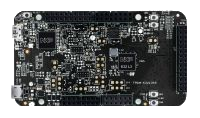FRDM-K32L3A6

-
Cores
Cortex-M4
Cortex-M0+
-
Device
K32L3A60VPJ1A -
CMSIS Pack
FRDM-K32L3A6_BSP
-
erpc_two_way_rpc_rpmsg_rtos_cm0plus
µVision AC6The Multicore eRPC Two Way RPC RTOS project is a simple demonstration program that uses the MCUXpresso SDK software and the Multicore SDK to show how to implement the Remote Procedure Call between cores of the multicore system. This multicore example shows how both the eRPC client and the eRPC server can be setup on one side/core (bidirectional communication) and how to handle callback functions in eRPC. The primary core (Core0) creates client and server tasks first. The client task releases the secondary core from the reset, initializes the RPMsg-Lite erpc transport and once the server task is running it configures the arbitrated client. Then the application logic is running. The secondary core (Core1) creates client and server tasks two. The client task initializes the RPMsg-Lite erpc transport and once the server task is running it configures the arbitrated client. Then the application logic is running. The client task logic of the Core1 is very simple, it repeatedly calls the increaseNumber() erpc function that is implemented on the Core0 and that increments the counter. The client task logic of the Core0 alternately issues either getNumberFromCore0() function implementation on the Core0 or getNumberFromCore1() function implementation on the Core1 (erpc call). Then, the nestedCallGetNumber() erpc function call is issued that alternately triggers either getNumberFromCore1() function implementation on the Core1 (normal erpc call) or it triggers the getNumberFromCore0() function implementation on the Core0 (nested erpc call, routed through the Core1 erpc server).
Download Pack -
erpc_two_way_rpc_rpmsg_rtos_cm4
µVision AC6The Multicore eRPC Two Way RPC RTOS project is a simple demonstration program that uses the MCUXpresso SDK software and the Multicore SDK to show how to implement the Remote Procedure Call between cores of the multicore system. This multicore example shows how both the eRPC client and the eRPC server can be setup on one side/core (bidirectional communication) and how to handle callback functions in eRPC. The primary core (Core0) creates client and server tasks first. The client task releases the secondary core from the reset, initializes the RPMsg-Lite erpc transport and once the server task is running it configures the arbitrated client. Then the application logic is running. The secondary core (Core1) creates client and server tasks two. The client task initializes the RPMsg-Lite erpc transport and once the server task is running it configures the arbitrated client. Then the application logic is running. The client task logic of the Core1 is very simple, it repeatedly calls the increaseNumber() erpc function that is implemented on the Core0 and that increments the counter. The client task logic of the Core0 alternately issues either getNumberFromCore0() function implementation on the Core0 or getNumberFromCore1() function implementation on the Core1 (erpc call). Then, the nestedCallGetNumber() erpc function call is issued that alternately triggers either getNumberFromCore1() function implementation on the Core1 (normal erpc call) or it triggers the getNumberFromCore0() function implementation on the Core0 (nested erpc call, routed through the Core1 erpc server).
Download Pack -
ewm_cm0plus
µVision AC6The EWM Example project is to demonstrate usage of the KSDK EWM driver.In the example, EWM counter is continuously refreshed until button is pressed.Once the button is pressed, EWM counter will expire and interrupt...See more details in readme document.
Download Pack -
ewm_cm0plus
Keil Studio AC6, GCC, IARThe EWM Example project is to demonstrate usage of the KSDK EWM driver.In the example, EWM counter is continuously refreshed until button is pressed.Once the button is pressed, EWM counter will expire and interrupt...See more details in readme document.
Download Pack -
ewm_cm4
µVision AC6The EWM Example project is to demonstrate usage of the KSDK EWM driver.In the example, EWM counter is continuously refreshed until button is pressed.Once the button is pressed, EWM counter will expire and interrupt...See more details in readme document.
Download Pack -
ewm_cm4
Keil Studio AC6, GCC, IARThe EWM Example project is to demonstrate usage of the KSDK EWM driver.In the example, EWM counter is continuously refreshed until button is pressed.Once the button is pressed, EWM counter will expire and interrupt...See more details in readme document.
Download Pack -
flexio_i2c_interrupt_lpi2c_transfer_cm0plus
µVision AC6The flexio_lpi2c_interrupt example shows how to use flexio i2c master driver in interrupt way:In this example, a flexio simulated i2c master connect to a LPI2C slave
Download Pack -
flexio_i2c_interrupt_lpi2c_transfer_cm0plus
Keil Studio AC6, GCC, IARThe flexio_lpi2c_interrupt example shows how to use flexio i2c master driver in interrupt way:In this example, a flexio simulated i2c master connect to a LPI2C slave
Download Pack -
flexio_i2c_interrupt_lpi2c_transfer_cm4
µVision AC6The flexio_lpi2c_interrupt example shows how to use flexio i2c master driver in interrupt way:In this example, a flexio simulated i2c master connect to a LPI2C slave
Download Pack -
flexio_i2c_interrupt_lpi2c_transfer_cm4
Keil Studio AC6, GCC, IARThe flexio_lpi2c_interrupt example shows how to use flexio i2c master driver in interrupt way:In this example, a flexio simulated i2c master connect to a LPI2C slave
Download Pack
